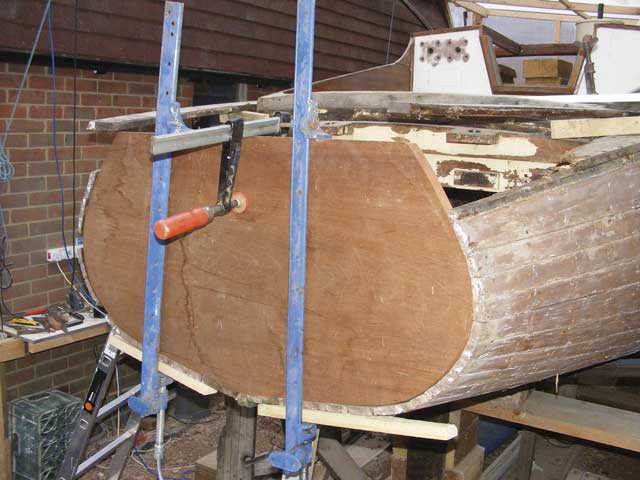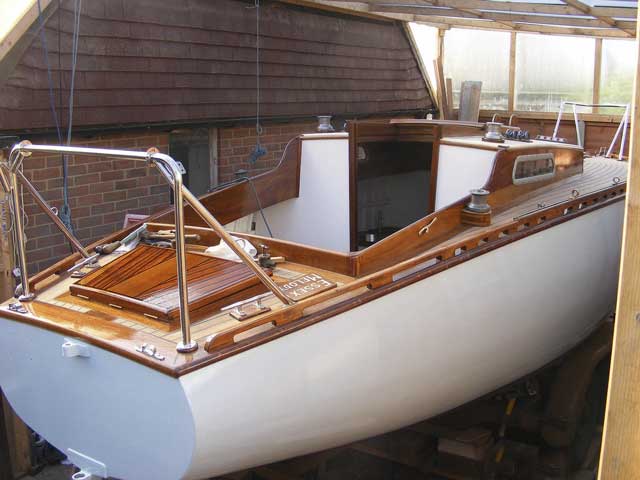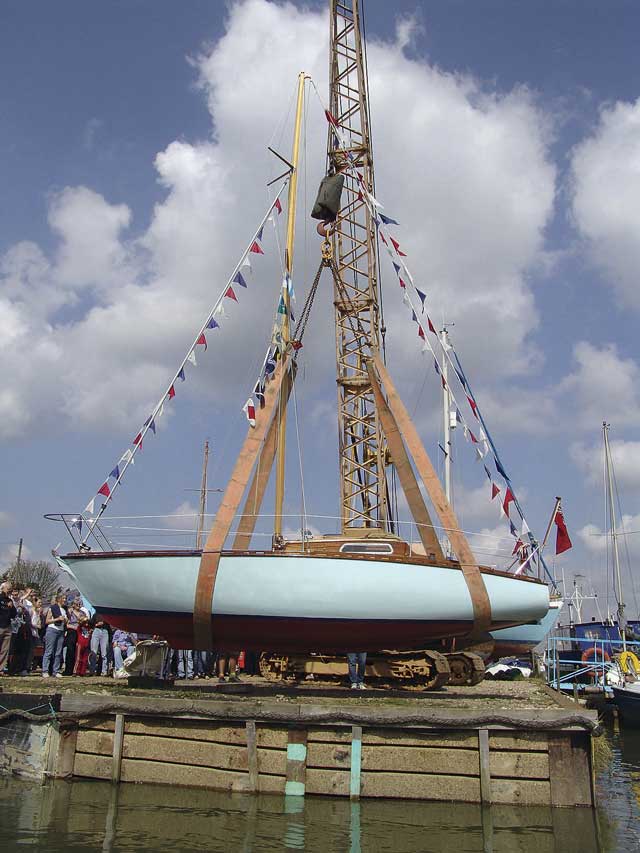John Rogers describes the heritage and restoration of Essex Melody, a classic, Maldon-built 23-footer which originally took to the water in 1959
At the end of a committee meeting at the Maldon Little Ship Club in January 2008, the Commodore announced that he had received this email from someone in Nottinghamshire. ‘Free of charge… a Maldon-built classic yacht with an interesting history. Essex Melody is in urgent need of TLC: perhaps one of your members is up for the challenge to bring her home to Maldon and save her?’
As it happened, my wife Diana and I were planning to drive up to Newcastle to visit a son, so we arranged to meet Essex Melody’s owner at the Criftin Caravan Storage facility near Newark where she had been abandoned for many years. As soon as we saw her we could not believe her sweeping lines, her incredible reverse sheer and tumblehome, so unusual yet so pleasing to the eye; certainly a unique and exceptional yacht which definitely needed saving!

Essex Melody in her dilapidated state.
Her covers had blown off and she was in a very dilapidated state as the elements had taken their toll. The deck, cabin and cockpit were completely rotten, but the hull – complete with forlorn-looking figurehead – looked fair, with only a few sprung and rotten planks. Fortunately the seams had opened up to let the rainwater drain out, but her Honduras mahogany had apparently resisted the freshwater ingress very well. The mast was broken and the rigging would all have to be replaced, but at least we could use it for a pattern. However, one overriding logistical feature which attracted us to Essex Melody was that she had a lifting keel and was obviously designed for the East Coast. She was also sitting on an old four-wheeled trailer which had supported the hull to keep it fair, and which meant that we could get her home and manoeuvre her far more easily than a deep-keeled yacht.
We were taken aback by the passion the current owners had for Essex Melody. She had obviously given them hours of pleasure around the Trent, the Wash and north Norfolk, and they had a real sense of guilt that their business commitments of starting their own microbrewery had resulted in her neglect. They spoke highly of her sailing qualities but also had a host of pictures and information, including articles from Yachting Monthly, as well as the name of her previous owner. They told us that she was built by John Scarlett along the lines of the first JOG (Junior Offshore Group) yacht Sopranino, and had pictures of Essex Melody being built and launched at Maldon in 1959. They also informed us that John was a member of MLSC and connected with the Old Gaffers Association, which confused us somewhat as she is Bermudan-rigged!
All this information and intrigue was too much for us: we liked the boat and her story, and with the owners keen that we should take her home to Maldon, we did not have much choice but to spend the most expensive £1 I have ever parted with. However, this became the start of the most exciting heritage project for which we could have ever have wished; we were rescuing Essex Melody, JOG no 74, from certain fate – an interesting 23ft yacht with an intriguing history.
We had the trailer repaired, and having survived a blow-out on the M11 we eventually got her safely home to Maldon in March 2008 and covered her up in our garden, asking ourselves: what have we done?
Researching her heritage
Once home, we started to research her heritage and gave her a preliminary survey to see if the expense of a full restoration was worthwhile. The more we found out about her, the greater the intrigue became: we made contact with all but one of her four previous owners, all of whom spoke highly of her sailing qualities and had their own fascinating stories to tell. One even gave us accounts in logs and pictures of cruises to Ostend, indicating what a fast and seaworthy boat she once was.

Sopranino, restored by the JOG, is on display at the Classic Boat Museum at East Cowes on the Isle of Wight

Sopranino hit the headlines when Patrick Ellam and Colin Mudie sailed this little 20-footer across the Atlantic in 1951
An archivist from the Classic Boat Museum at Cowes came to view Essex Melody and was emphatic that her exceptional heritage qualities needed preserving, while a local surveyor confirmed that the planking of the hull was far more sound than we had suspected. Researching the heritage of Essex Melody prompted us to obtain the book Sopranino, which depicts the incredible history of the development of the small ocean-racing JOG yachts during the post-war austerity of the 1950s. JOG safety standards were set in place in 1950 by Captain John Illingworth and the theta (‘q’) symbol of the class is derived from an early trial boat called Theta. Sopranino was therefore given the sail number q1.
Sopranino, designed by Laurent Giles, hit the headlines when Patrick Ellam and Colin Mudie sailed this little 20-footer across the Atlantic in 1951. They became national heroes, and enabled a generation of young men to realise that they did not need a deep pocket and a large ocean racer to cross oceans safely. Amongst those inspired by this achievement was John Guzzwell, who built the 20ft 6in Trekka in his back garden and sailed her around the world in 1955. Meanwhile, John Scarlett set about designing his dream boat Essex Melody in Maldon, laying the keel in 1957 and launching her in 1959.
The building of Essex Melody

Unfortunately, John Scarlett died prematurely, aged just 53, in 1984, but we had the privilege of meeting up with his widow, who gave us a great deal of information and background to the building of Essex Melody. We were informed that while working as an electrical engineer at Marconi in Chelmsford during his early 20s, John decided to design and build a boat along the same lines as Sopranino. However, his boat was to be made 3ft longer, carvel built and with a lifting keel to make her suitable for the shallow waters of the East Coast.
He almost certainly sought advice from Illingworth and Giles, but after much thought, research and calculations came up with his own superb scale model rather than drawing a formal design on paper. We were also shown a handwritten manuscript of over 100 pages for a book entitled From Dream to Reality, in which John explained his reasoning behind the design of Essex Melody: but unfortunately he never completed it before his death.
In 1957 he had the keel cast at Maldon Iron Works and placed in Dan Webb and Feesey’s yard in Maldon, where he set to work building her out in the open in an area called the orchard, which is now the car park of MarineStore. Being an amateur shipwright, John was very dependent on the help and advice of Jack Feesey, famous for his Blackwater sloops. However, even though he enlisted the help of apprentice shipwrights he largely accomplished the construction himself, despite being in full-time work with Marconi.
As a true research scientist he documented every hour he spent building Essex Melody, and took pictures at each stage of her construction.
Finally, in September 1959 – after 3,581 hours’ work – she was launched from the yard in the presence of Eric Payne, the Commodore of Marconi Sailing Club.
The restoration begins…

The decaying cabin and deck

The rotting transom needed replacing, and was removed

The new mahogany transom was fixed in place

The cast iron centreplate, shot-blasted and painted

Broken timbers needed replacing

Every seam was re-caulked

New bulkheads strengthen the hull

Iroko strips laid on the sub-deck

Caulking and sanding made a sturdy, attractive deck

The hull complete, and ready for the deck fittings
With her extensive heritage background, Essex Melody was a compelling case for a full restoration. We built a boatshed around her in our garden in Maldon and she became our heritage project and a great source of local interest.
We had some knowledge but were on a steep learning curve, relying on the services of local shipwrights, spar makers, riggers and sailmakers, making the restoration a great project management experience itself. We found an excellent shipwright who was supported by a local wooden boat surveyor: his advice was invaluable and gave us a great deal of confidence.
After a thorough assessment we stripped out the entire interior of the boat and then systematically removed the cockpit, cabin and deck to make the inside of the hull fully accessible. The next job was to burn off the paint inside and out to expose any broken timbers and soft planks. The lifting keel was removed and then the long central stub keel, along with the keel box and its supporting logs. These had to be remade or renovated then systematically replaced, while stainless steel bolts were used to refit the keel.

Getting started: removal of the deck and cabin gave full access to the hull interior

Making progress: the new timbers and renovated plate box looked impressive
The next job was to source green oak, which we selected from a local woodland then prepared it to replace the numerous cracked timbers. This was achieved by steaming and scarfing them on to the upper parts of the existing timbers. Occasionally, inaccessible timbers were doubled or a laminated timber had to be made up. The timbers were secured by copper rivets, and it was a new experience for me holding the dolly outside while the shipwright did the hammering inside. We also found that many of the untouched rivets needed replacing or hardening up.
Several upper planks towards the stern were found to be soft and needed replacing, while the outside of the hull was treated with a solvent epoxy to help preserve it. Meanwhile, two new bulkheads were made from marine ply and coated with epoxy mat to preserve them.
Practical and pleasing
The next problem was the transom, which was fairly lightly built and needed replacing with a new piece of mahogany. Once this was done, the cabin sides and cockpit could be fashioned, and the marine ply sub-deck could be screwed on once all the oak deck beams had been renovated: only a few needed completely replacing. To complete the side decks we decided on strip plank iroko, epoxy-bonded to the sub-deck and with Sikaflex deck seams, which made a practical and pleasing finish.
We plumped for an open cockpit with slatted seats and floor, and new washboards were made for the cabin. The forehatch was renovated and reusable, but the lazarette needed a new hatch. Meanwhile, the interior of the cabin was fitted out simply with sapele-edged marine ply furniture to make a galley and spruce-slatted bunks to make comfortable accommodation for two people, albeit with sitting headroom only.
The 28ft hollow mast was completely rotten so we commissioned a local spar maker to construct a new one, along with enormous spreaders and jumper stays for the top diamond of the rigging. New mast bands had to be fashioned out of polished stainless steel, and eventually the local riggers made a complete set of standing and running rigging.
I am fortunate enough to also have an old Southerly 100 so I set up the running rigging in the same way, with all the halyards and slab reefing lines coming back to the cockpit. As for the sails, the old set was checked for size and taken to a traditional sailmaker, who hand-cut a new set.

In she goes…
Despite erring from the original JOG standards, we had saved Essex Melody and made her once again into a worthy little yacht. We were astounded by the cost of our fairly modest restoration, and recognise how easily huge sums can be spent. We also admire those individuals who, by taking longer and doing most of the work themselves, save a lot of expense; but my skills were not up to this!
After 18 months of hard work and the help of many friends, Essex Melody was taken to MarineStore and relaunched in the same place where she was first launched in 1959. To celebrate the relaunch on April 16 2011, John Scarlett’s daughter and grandchildren poured champagne over the figurehead in the presence of around 100 people as Essex Melody was gently craned into the Blackwater. Among the guests were the previous owners, the skilled shipwrights, friends and family who had supported the project, plus several Elder Gaffers including cartoonist Mike Peyton, all of whom knew John Scarlett at the inception of the OGA.

Around 100 people attended Essex Melody’s relaunch in April 2011

Essex Melody’s figurehead (left) gets doused in champagne

Essex Melody’s heritage alone justifies the time and expense of her restoration, but as a bonus she has proved to be a fast and delightful little yacht, handling immaculately and winning several trophies at local regattas. This is of great credit to her designer John Scarlett, who did not have the luxury of computer modelling or prototype trials – only the lines of Sopranino as a starting point. Essex Melody is a unique example of a JOG yacht: she certainly is a head-turner, and John Scarlett seems to have got it right first time!

Essex Melody takes to the water: a stirring sight




